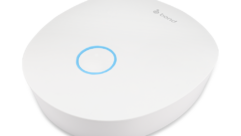The Wired Life
Aug 1, 2003 12:00 PM,
Frank Koditek
Structured cabling systems, long a standard in the premise marketplace, have successfully crossed over into the fast-growing residential market, fueled by increased consumer demand for high-speed voice and digital communications, computer and whole-house networking, security and systems automation, distributed audio, video, and home entertainment systems.
The Yankee Group, a technology industry analyst firm, estimates that the number of networked homes will reach 9.95 million by the end of 2003, up from 660,000 in 1998. Before the dawn of the digital revolution, there were relatively few standards followed in the design and installation of home cabling. Today’s high-end home builders and tech-savvy consumers are beginning to understand and appreciate the value proposition of structured cabling systems that meet TIA/EIA-570A residential cabling standards, as well as the data communications standards for Cat-5 and Cat-5e performance covered under TIA/EIA-568-B.2.
For the vast majority of consumers, specifying and installing a home networking system is not looked upon as a do-it-yourself project but as something better left to qualified home integrators and installers. According to a survey of 1,000 U.S. consumers, 87 percent reported they would seek the help of a certified professional to install their home networking system. A National Association of Home Builders study reveals that 34 percent of builders now offer structured wiring packages as standard or optional amenities.
Thus, it has become the responsibility of system designers, integrators, contractors, and installers to ensure that the systems they recommend, specify, and install meet the quality and performance requirements of home builders and the consumers they serve. In this article, I will take a closer look at how structured cabling systems provide the optimal infrastructure for today’s intelligent home and offer a few guidelines about cable selection and installation.
CATCH THE DIGITAL WAVE
What are consumers looking for in their home networking, automation and entertainment systems in this digital age? For some it may be multiple voice and data lines and high-performance, reliable computer networking to support a home office, a small business, or family Internet use. Others want to implement state-of-the-art, whole-house security and intercom systems. More technologically advanced consumers may also be contemplating computer-controlled networks for distributed audio/video, HDTV, and sophisticated digital home-theater installations, as well as automated control of HVAC systems, appliances, indoor and outdoor lighting, and the heating of swimming pools and hot tubs. The applications are virtually endless and will continue to grow as exciting new technologies emerge.
When it comes to the cabling system infrastructure, high-end consumers want — and indeed expect — high-quality, long-term performance and optimal flexibility to expand applications at will, without ripping out walls or disrupting the household. For many builders and homeowners, putting the best cabling infrastructure behind the wall from the start is no longer a luxury but a necessity.
In fact, installing a structured cabling system at the outset reduces the need for costly retrofits down the road while providing the flexibility and bandwidth required for current and future applications. For system designers and installers, this option provides higher up-front profits, easier installation, and more satisfied customers.
FUTUREPROOF
Traditionally, residential installers used single specialized cables for room-specific voice, data, audio, and video applications — four-pair UTP cables for phone, fax, and dial-up Internet hookups; Series 6 coaxial cable for one or more CATV connections; and audio cables for the sound system.
When it comes to structured cabling system design, however, it makes more sense to use composite cables, which bundle these components within a single jacket. This innovative design makes Cat-5 or Cat-5e installation faster and easier and also provides ample flexibility for expanding applications. Composite cables typically include one or two four-pair UTP cables, which can handle four phone or as many as two data lines each and provide many times the bandwidth of regular telephone cable, as well as one or more Series 6 coaxial cables, the standard for video transmission and cable-based Internet service. Sometimes a fiber-optic cable is added to the mix for future technology implementation.
The beauty of a structured system built on composite cabling instead of individual, dedicated cables is that any room in the home can thereafter be equipped for computer networking and multimedia, HDTV, cable and direct broadcast satellite television, multiline telephone service, security and energy management systems, and much more. If carefully selected and performance verified, the system will easily handle new and emerging technologies and applications. That is why most system designers and contractors find it makes good business sense to specify Cat-5e rather than Cat-5 cable. The cost differential is small compared with the quality and performance advantages gained, including the potential for significantly higher speeds and greater capacity.
CABLE QUALITY
In selecting composite cabling, it’s important to recognize that there can be enormous differences in quality among cables. Seeking out a high-quality cable is worth the time and effort, because replacing nonconforming cable with an upgrade after installation is costly in terms of time and money and especially in terms of customer confidence and satisfaction.
A good rule is to choose composite cables specifically designed and manufactured to meet certifiable performance standards, both before and after installation. For the UTP portion of the composite cable, this can be termed Installable Performance. Taking such an approach ensures that a structured cabling system has been tested and third-party verified to the TIA/EIA 568-B.2 standard and will actually perform to that level, even after years of use.
In recent years, innovations have been introduced to foster Installable Performance. One such innovation is Bonded-Pair technology. Bonded-Pair UTP cables feature a design in which the individual insulated copper conductors are affixed together along their longitudinal axes, resulting in uniform conductor-to-conductor spacing. The result is two perfectly balanced conductors that are mirror images of each other to provide balanced signal transmission and avoid the problems that can result from lack of concentricity.
With unbonded UTP pairs, gaps can form between the two conductors, causing an impedance mismatch and reflection of portions of the signal within the cable/system. That is known as return loss (RL). RL is especially important in networking schemes (such as Ethernet) that use bi-directional transmission. Bonded-Pair cables, on the other hand, provide consistently superior impedance and RL performance. They are also more immune to electrical noise from the environment, such as EMI, RFI, or crosstalk from other pairs.
For broadband applications, look for coaxial cables that are performance tested from 5 MHz to 2.25 GHz. Solid copper conductors provide the bandwidth requirements for CATV along with the voltage requirements of satellite applications. An industry innovation in shielding features a three-shield construction consisting of foil tape surrounded by an 80 percent braid as well as an outer layer of foil with a shorting fold. That combination offers superior high-frequency shielding when compared with traditional quad shields and can be stripped in a single step for easier installation.
SANS JACKET
New to the Cat-5e composite cable scene is a distinctly constructed cable that makes installation simpler as well as more efficient. These UL-verified cables feature a center-spline design that eliminates the need for an overall jacket, making the cables easier to handle and making the individual cables within the bundle easy to identify, pull off and terminate. Because the overall jacket has been eliminated, the cable’s outer diameter is smaller than traditional composite cables, improving the overall bend radius for easier installation.
PROGRESSIVE HOMES
TNT Development, a progressive custom home developer in Southern California, recently launched its Walnut Country Homes community of luxury homes, built specifically to propel home buyers into a high-tech future of home automation, home networking, and advanced multimedia applications. Each of these 4,000- to 4,600-square-foot homes features an industrial-strength structured cabling system that enables computer networking, distributed music, video, and home entertainment, as well as home automation, security systems, and remote monitoring, with additional capacity built in for future expansion.
Inside each residence, the composite cables are installed in a star topology with each cable home-run from a central distribution center in the master bedroom to each designated room. This flexible configuration makes it possible to quickly implement changes and deploy new applications as family needs change over the course of years.
At Walnut Country Homes, the standard installation options include front- and rear-door surveillance cameras, video modulators, high-speed Internet gateway, Ethernet hub, digital cable or satellite amplifier and hub, four-line telephone module, and wall-mounted and handheld remote lighting controls for automated lighting preinstalled in key areas of the home. Upgrades to these features and other optional electronics — such as satellite dishes, speaker outlets, and additional digital cameras — are offered by the builder at the outset so home owners can feel confident the installation and integration of their complete system will be turn-key and hasslefree.
One satisfied Walnut Country homeowner says, “At first the ‘connected home’ concept, while appealing, did not mean a great deal. Since we’ve been living with all these technological advancements though, it has brought our entire family to a new level of smart and convenient living.”
BUILDING VALUE
The lesson to be learned from the commercial structured cabling marketplace is that designing and installing technologically advanced communications system makes good business sense for cable system designers, installers, and their customers.
Building in ample headroom for future applications not only adds value to the home and protects the original investment, but more importantly, it helps consumers avoid costly and time-consuming upgrades and retrofits later. On the contractor side, the benefits of specifying high-speed, high-performance structured cabling systems include greater opportunities to cross-sell and up-sell system components, higher up-front profits, and a dramatic increase in customer satisfaction.
Frank Koditekis marketing manager of home automation for Belden Electronics.










